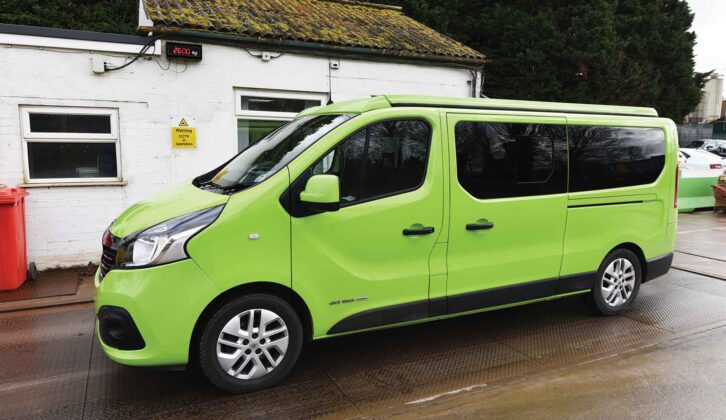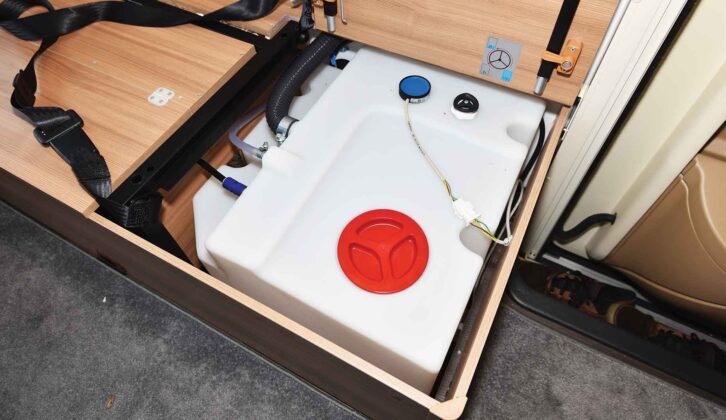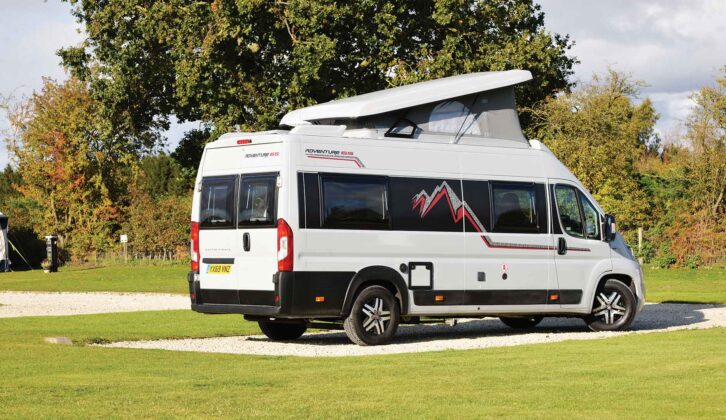Making sure you are aware of the relevant motorhome weights is a crucial part of driving legally and safely. All road vehicles in this country have specific limits on their weight; the details will be stamped on the VIN plate.
Safely driving a ‘van does not just involve asking yourself ‘what driving licence do I need to drive a motorhome?’ – it will also involve being aware of the relevant weights of your ‘van and ensuring you don’t overload it. Exceeding any or all of these weight limits is illegal and may lead to heavy fines or even put an end to your UK road trips until it’s corrected.
The good news is these various terms you may have heard of are not as complicated to understand as you may think. Here, we talk you through everything you need to know about your van’s weights, including the motorhome you can drive on your licence, as well as defining the critical terms, such as MiRO, MAM, MTPLM and GTW.
Motorhome weights explained:
Terms you need to know
What weight of motorhome can I drive on my licence?
Checking your motorhome VIN plate
Motorhome MAM weights
Motorhome payloads explained
How to weigh a motorhome
What if you drive with an overladen motorhome?
Upgrading a motorhome’s weight
Motorhome weights: terms you need to know
Mass in Running Order (MiRO)
This is the weight of the motorhome when it leaves the factory, including all of its factory-fitted equipment. We would advise checking with the manufacturer to see exactly what they define this as – in some cases, brands add weight to include a driver, a tank of fuel, and more.
Maximum authorised mass (MAM) / Gross vehicle weight (GVW) / Maximum technically permissible laden mass (MTPLM)
It can be easy to get confused about these three terms, but the MAM, GVW and MTPLM are all the same thing – this is the most your motorhome can weigh, as defined by the manufacturer.
Payload
Owning a ‘van is not just about packing it with the best motorhome accessories. Instead, you’re going to want to be aware of the payload before you think about loading a motorhome – this is the weight of items that can be loaded into your ‘van, including passengers. Work it out by subtracting the MiRO from the MTPLM.

Maximum axle weights (MAW)
You need to ensure you do not exceed the weight limits of your ‘van’s individual axles – this can be checked at a weighbridge.
Gross train weight (GTW)
This is the maximum weight that a trailer and vehicle combined can weigh, and includes the loads within each.
What weight of motorhome can I drive on my licence?
Before you think about buying one of the best motorhomes, you should make sure you check your driver’s licence so you know what weight you can legally drive.
The exact categories that apply to you are very much going to depend on when you passed your test and will also have an impact when it comes to motorhome towing. As a starting point, take a look at the reverse of your driving licence.
Having the regular B category licence will allow you to drive a motorhome with a MAM of up to 3500kg, such as the Panama P12.

If you passed your test before 1 January 1997, you will generally be able to attach a trailer of up to 4750kg too – however, if you passed it after this date, you will find your trailer weight is limited to up to 3500kg. We will add that you’re unlikely to get to these maximum weights when towing, simply because the actual limit will be determined by the vehicle’s maximum towing weight, which, for a motorhome, is typically around 2000kg.
A trailer can also be towed with a BE category but this will be within the limit of the tow vehicle’s maximum towing capacity.

Those who have a C1 category will be able to drive a motorhome of 3500-7500kg MAM, such as the Benimar Mileo 294, and can tow a trailer of up to 750kg. Those with a C1E will be able to tow a trailer of over 750kg but are unable to exceed a combined mass of the motorhome and trailer of 12,000kg.
The maximum combined train weight mass will generally be subject to an extra code limit – as an example, the ‘code’ 107′ limits this to a combined weight of 8250kg.
Take a look at gov.uk/driving-licence-categories and gov.uk/driving-licence-codes for more on this.
Another point we will highlight – exceeding the 3500kg MAM can mean extra hassle for those who are over 70. While they will need to renew their driving licence every three years to keep their B category, retaining the C1 category will require a bit of extra work, with an extra form needing to be filled in, a medical report required from their doctor (generally requiring a fee) and then the application needing to be sent off by post.
Checking your motorhome VIN plate
Our resident expert Gentleman Jack considers knowing your ‘van’s relevant weights as one of his crucial motorhome driving tips. The VIN plate is often a metal plate attached under the bonnet somewhere, but it might be a printed label attached in a cab doorway.
On it will be the VIN (Vehicle Identity Number) along with the Maximum Allowed Mass (MAM), Maximum Train Weight (MTW), and Maximums for front axle weight and rear axle weight (these will be often listed as axle 1, axle 2, axle 3 (tandem axled vehicles).
The MAM is simply the maximum the vehicle is legally allowed to weigh; this will include everything carried in the vehicle.
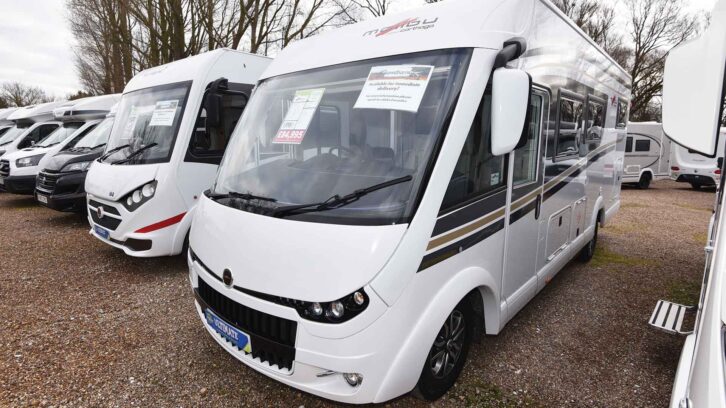
MTW is the legal maximum the vehicle and any trailer it pulls may weigh, while the individual axle weights are the legal maximum weights for each axle.
It is very often the case with motorhomes that, while the MAM is not exceeded an individual axle limit can be; often the rear axle but sometimes the front.
Overloading of one axle can usually be rectified by simply moving items to a different location in the motorhome.
A few A-class motorhomes built on lighter chassis will struggle to remain legal on the front axle due to the body adding a significant load at the front, as well as having a large drop-down bed.
Motorhome MAM weights
Often the MAM is lower than the axle totals to allow for variations of loading.
The MAM can often be uprated; first as a paper exercise to raise the MAM to the total of the axle weights, usually upgrading a 3500kg motorhome to around 3850kg MAM, but this doesn’t alter individual axle limits.
Axle limits can be uprated, but will usually involve upgrading suspension and tyres.
Air-assist rear suspension can often increase a rear-axle limit and thereby the MAM.
Front axle limits can be raised, usually by fitting stronger springs. Motorhome tyres will often need to be upgraded to allow an axle upgrade, so allow for a set of tyres in your costing.
Motorhome payloads explained
If you’re thinking of buying a motorhome that has a 3500kg MAM, such as the Pilote P720U Expression, you need to focus on the payload. Manufacturers often refer to Mass in Running Order (MiRO) and this is meant to be the weight of the vehicle with touring kit on board.
Typically, this will include a full fresh-water tank, a 90% full fuel tank, a full 16kg gas cylinder and a driver allowance that is typically 75kg. This MiRO figure is subtracted from the MAM to calculate the payload.
But the MiRO calculation is not standardised among manufacturers and it doesn’t take a genius to see a few issues with this calculated figure.
For starters, you may not weigh 75kg and it doesn’t take into account the weight of the rest of your family and the dog. Then there’s the weight of all the usual extras carried by every ‘van owners – food and drink, motorhome toilet chemicals, clothing and so on.

At best, MiRO is a rough guide to what the motorhome might weigh, but you really need to read the small print for each manufacturer, to see how it is calculated.
Then there are a few other issues to be aware of. Often, manufacturers will quote the payload weight of a basic-specification vehicle that doesn’t take into account the fitting of any optional extras. If you’ve been thinking of buying a motorhome at a show, you’ll probably be aware of the show deals that include free TV packages, an awning and all manner of other goodies can really eat into this payload.
You might also want to add a few accessories before you collect the vehicle, such as a bike rack or air-con for the habitation area. The weight of all these needs to be accounted for
Manufacturers will detail the weight of these items in the brochure, but you need to do the maths to see what you can safely add. It might not be possible to add it all and still have a meaningful payload left for your touring kit.
If you’ve been in two minds between a campervan or motorhome and decided you want a pop-top roof, don’t forget that they will also eat into your payload.
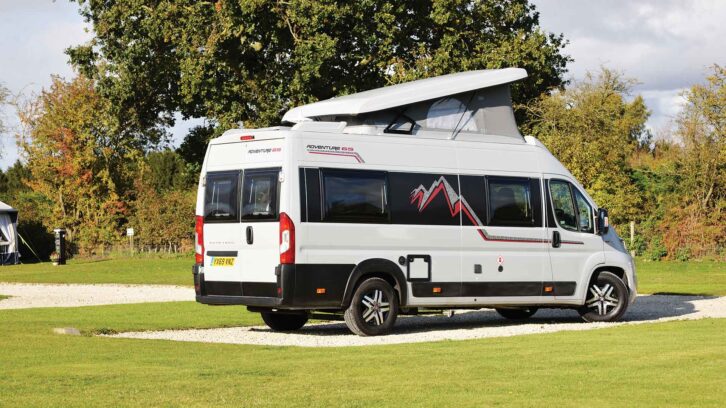
Accessories will often weigh more than you think. For example, air-con can add 35kg, and a wind-out awning, as much as 55kg. As owners of the best motorhome bike racks will be aware, these accessories can typically at around 10kg, but don’t forget that the bikes themselves reduce your payload and can often be about 15kg each. Two ebikes on a bike rack can easily weigh around 60kg in total.
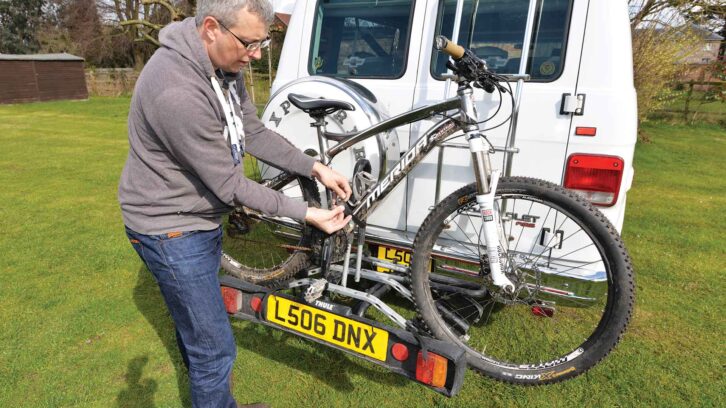
Some extras can increase your payload, though. These can include alloy wheels (not always – the larger diameter ones tend to be heavier) and lighter lithium leisure batteries.
It is highly recommended to have any motorhome you’re considering – either new or used – weighed by the supplying dealership as part of the contract. Especially if it is plated to 3500kg MAM. Weighing the vehicle after you take delivery could lead to all manner of complications, so sidestep this at the point of sale.
How to weigh a motorhome
If you’ve never visited a weighbridge, you need to do so now. These vehicle weighing pads can be found via your local council (just search for ‘public weighbridges’), at scrapyards and agricultural merchants. Before your visit, fill the fuel and water tanks, and make sure you’re carrying all of your usual touring kit.
Then simply visit them to weigh the whole vehicle and, most importantly, either your front or your rear axle. Subtract this axle weight from the total and that will give you the weight acting on the axle that you haven’t weighed. This gives you three weights: front axle weight, rear axle weight and total axle weight.
You must have all three weights and a print-out from the weighbridge. There will be a small charge for this, but it won’t be expensive.
Armed with this information, you can then compare the maximum actual weights with the plated maximum axle limits of the vehicle. These are detailed on the chassis plate, usually found under the bonnet or on the door jamb.
Most modern 3500kg MAM ’vans run very close to their maximum weight. It is so common that the European Tyre and Rim Technical Organisation advises that CP (camping) tyres should be run at 80psi (5.5 bar) to account for this weight. At pressures above 65psi (4.5 bar), metal tyre valves are considered advisable.
It is also generally advisable to get motorhome tyre pressure recommendations from your tyre manufacturer, after obtaining the actual individual axle weights of your leisure vehicle.
What if you drive with an overladen motorhome?
If you think visiting a weighbridge sounds like a bit of a hassle, there are a few points to bear in mind.
First, it’s the driver’s responsibility to know the vehicle’s weight. Legally, if you plead ignorance, that isn’t a valid defence and you’ll be found guilty.
“Ah, but they have to catch me first,” you might be thinking. However, there is a lot of technology about to do this. Weight in Motion systems – essentially rubber strips on the road linked to ANPR cameras – do precisely what they say and can weigh each axle as you drive over them at motorway speeds. They will automatically issue a ticket if your vehicle is overladen compared to its plated weight.

The DVSA, which is responsible for monitoring overladen vehicles, often takes a keen interest in motorhomes and can be found checking weights at leisure vehicle shows. Many are found to be overladen – it is not uncommon.
If you are caught overladen, the penalties can be severe. Fixed penalty fines range from £50 to £300 and can be accompanied by three points on your licence. For heavily overladen vehicles, they also have the power to prosecute you. Get caught twice within 28 days and you’ll almost certainly be issued with a summons.
So, as mentioned, if you have never visited a weighbridge, now’s the time!
Upgrading a motorhome’s weight
If you’ve tried all our tips to reduce the weight of your motorhome but it’s still overweight, there are a few things you can do. But you will need to have the C1 category on your driving licence, the type of licence you would need to drive heavier motorhomes such as the Le Voyageur 7.6 GJF Heritage, which has an MTPLM of 4500kg.
If you don’t have this and want to add it, you’ll need to take some training (which isn’t cheap – one-day courses start at about £400 excluding test fees). If you don’t have C1 and don’t want the cost and hassle of adding it, you’ll have to consider swapping vehicles.
Assuming you have C1 entitlement, you could apply to have the vehicle replated. SV Tech are specialists in this field and can help to uprate the vehicle.
Sometimes this is a purely paper exercise and you might be able to increase the weight limit to around 3850kg, but this very much depends on the individual axle weight limits
of your particular motorhome.

If the ’van’s original chassis or suspension can’t support the extra weight, some modifications – such as the addition of air suspension (which is a brilliant upgrade for all motorhomes) might be needed. Contact SV Tech and they can advise you on what is possible.
Once your vehicle has been replated, you’ll be issued with a new chassis plate sticker to attach to it, and you’ll need to inform the DVLA of the changes in revenue weight (which
will affect the road fund licence classification), and inform your insurance provider. Typically, swapping the V5C logbook from taxation class PLG to PHGV (Private Heavy Goods Vehicle) reduces the cost.
Replating doesn’t affect the MoT class (usually class 4), but you’ll still need to find a test centre capable of dealing with the sheer size of a ’van – not all will be able to test them.
The final word on motorhome weights
Weight limits aren’t something that you can ignore and with increasing amounts of technology now targeting overladen vehicles, it’s not a matter of if you’ll get caught, but when.
So don’t stick your head in the sand on this one and make that visit to your local weighbridge.
Once you’ve sorted out your motorhome’s weights, you can start thinking about setting off on tour. Knowing how to level a motorhome can make a big difference to your overall enjoyment when you’re pitched up, helping you enjoy a better night’s sleep.
Written with contributions from Diamond Dave.
Future Publishing Limited, the publisher of Practical Motorhome, provides the information in this article in good faith and makes no representation as to its completeness or accuracy. Individuals carrying out the instructions do so at their own risk and must exercise their independent judgement in determining the appropriateness of the advice to their circumstances. Individuals should take appropriate safety precautions and be aware of the risk of electrocution when dealing with electrical products. To the fullest extent permitted by law, neither Future nor its employees or agents shall have any liability in connection with the use of this information. Double check any warranty is not affected before proceeding.
If you enjoyed reading this article, why not get the latest news, reviews and features delivered to your door or inbox every month? Take advantage of our brilliant Practical Motorhome SUBSCRIBERS’ OFFER and SIGN UP TO OUR NEWSLETTER for regular weekly updates on all things motorhome related.


